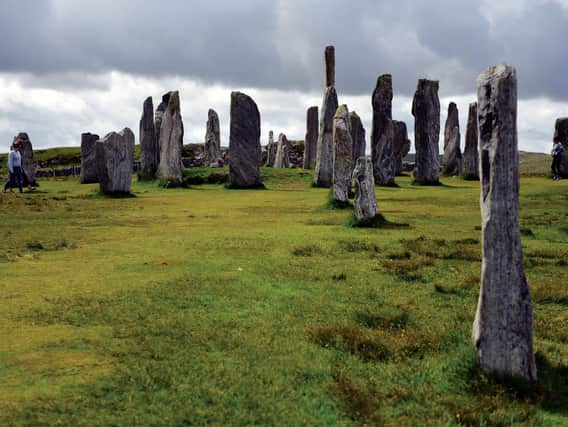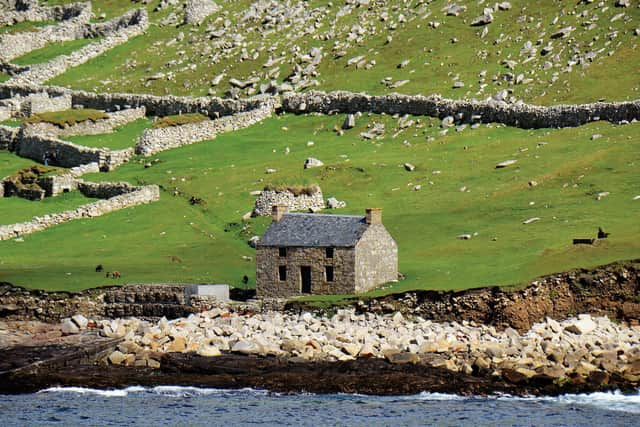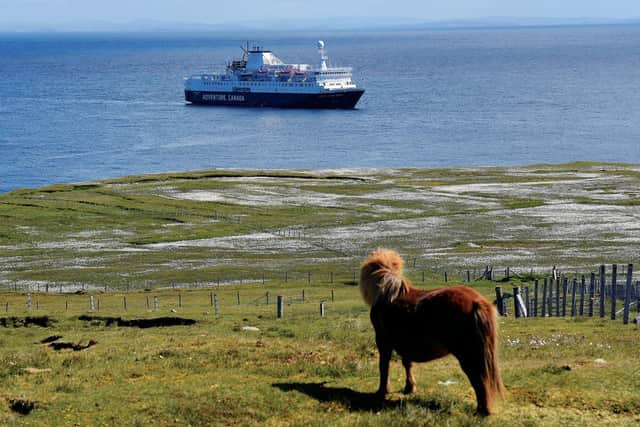Travel Wishlist - Scottish islands cruise - Scotland on Sunday travel


Trundling along narrow roads on a warm June day we hugged the natural curves of Loch Lomond as we made our way to Oban to embark on our 11-day circumnavigation of Scotland with our host, Adventure Canada, a leading expedition cruise company.
This was not a luxury cruise, but a voyage of exploration focusing on culture, history, wildlife spotting and visiting small communities and hard to reach islands that rarely see visitors, north from Oban to Islay, Iona, Skye, St Kilda, Lewis, Orkney and Shetland, before returning south and dropping anchor in Aberdeen.
Advertisement
Hide AdAdvertisement
Hide AdCarrying 198 passengers, the 137-metre Ocean Endeavour has 20 Zodiacs or rigid inflatable boats, used to get to shore or cruise into hidden bays.


Leaving Oban around 9pm, we watched the sun setting over small islands heading for Islay and the following morning sailed into Bowmore near the distillery that has made the town famous for its peaty whiskies. At Loch Finlaggan, the first historical site of the voyage, we explored the Great Hall – now little more than two triangular end walls made of stone, for almost three centuries it was home to the Lords of the Isles. It was from here in 1164 that Somerled, the great lord of the western isles, organised his momentous invasion of the Scottish mainland, the first great clash between two Celtic-world cultures: Norse-Gaelic and Anglo-Norman.
Our arrival off the shores of Staffa the following morning coincided with a storm that impeded our landing on the island. However, the Zodiac cruise around the geologically unique island, formed through three distinct volcanic eruptions, was spectacular, and as afternoon arrived we landed on the holy island of Iona, where we hiked to the impressive Abbey.
Isleornsay Harbour on Skye greeted us next morning, not a planned stop, but faced with southwesterly winds gusting 65 knots we had sailed along the Sound of Sleat to one of the most protected harbours on the east coast of Skye to spend the day, shipbound.
On the Isle of Lewis The Dun Carloway Broch, Gearrannan Blackhouse Village and the Callanish Standing Stones, arranged in a Celtic cross and dating back 5,200 years, were highlights, rounded off with a visit to Stornoway, home to 7,000 and the largest Hebridean settlement.


Waking early as we approached the St Kilda archipelago, I raced to the bridge to watch the scenery unfold at the westernmost Scottish islands. All elements were working together that day to make it one of the most successful, sunny and serene settings of our voyage.
A large swell meant we couldn’t land in the morning at Hirta, the main island, so we sailed on to the bird cliffs at Stac Lee – a chunk of towering black rock sticking straight up from the sea and plastered in white bird guano. It’s the largest gannet colony in the world after the Bass Rock.
Approaching, thousands of birds came into view and our captain performed a skilled manoeuvre, slowly positioning us right in front of the stac. We were transfixed by the tornado of wheeling birds swirling around the top of the towering black rock wall, so close I felt I might get sucked into the vortex. Among thousands of swooping birds, we enjoyed a back-deck barbecue, trying to avoid any bird guano toppings!
Advertisement
Hide AdAdvertisement
Hide AdBy afternoon we dropped anchor at Hirta and explored the once inhabited tiny island, with its ancient cleits, or stone hut homes, and rare, free-roaming sheep in the village street. Climbing 150 metres up the steep saddle between two hills offered views of the island in one direction, and the cliff edge in the other.


Our next landing was Loch Scavaig, on the Isle of Skye again, where we hiked under blustery grey skies in the dramatic Cuillin Mountains.
Sailing north towards Orkney through strong wind, by 3am we reached vast cliffs at Dunnet Head, a beautiful, remote, windswept outpost, and the UK’s most northerly point. There’s an old Stevenson lighthouse and a cluster of what were old coastguard cottages which today are privately owned.
In September 1926, after serving in the Royal Navy during the First World War, my great-grandfather, Arthur Charles Roberts (and his wife, Jean) was posted to HM Signal Station at Dunnet Head (Thurso) to serve as a coast guard. The couple travelled from southern England all the way north by train and on Impshi, my great-grandfather’s motorbike (and sidecar).
Back in 2017, I had taken a road trip around Scotland’s coast to visit Dunnet Head, and having discovered that Richard Clack was now the owner of one of the remote cottages, I contacted him. He and his dog Bonnie showed me around the old and mostly uninhabited cottages, pointing out the actual rooms where my ancestors lived and worked. It was a special moment, treading in their footsteps.
I’d told Richard we’d be sailing past Dunnet Head at around 3am the following morning and he said he’d wait up and light the huge lamp on the top of the cliff to say hello.
I made my way to the bridge where the crew were expecting me and one of the ship’s large and very bright spotlights was directed towards shore. We saw a bright light flashing on and off: it was Richard signalling. We’d made contact.
A few hours later we docked in Orkney where we would overnight docked in Kirkwall, sparing us a rough night at sea.
Advertisement
Hide AdAdvertisement
Hide AdOn borrowed Adventure Canada bicycles, and battling the elements, we eventually made it to town 15 minutes later. There we visited 12th-century St Magnus Cathedral to see the grave of Arctic explorer and doctor John Rae, originally from the islands. This mission was disrupted by the sight of a familiar figure in search of the same thing. We hadn’t expected to run into actor Bill Murray, in town playing with his group of classical musicians. Later, we went with him to a small shop where he bought knitwear for a friend, asking local ladies for their opinion on his purchase.
Getting right down into the neolithic Broch of Gurness on Mainland, Orkney, we learned how people lived there and at Skara Brae way before Egyptians built the pyramids and three or four hundred years before neolithic people started work on Stonehenge. Skara Brae is the best-preserved neolithic village in northern Europe and offers an insight into those who lived here 4,500 years ago; and the nearby Ring of Brodgar, a world-famous ring of standing stones, is well worth visiting too.
Finally to Sheltand, and with the wind dropping below 10 knots, we boarded Zodiacs and made our way to shore at Foula, spotting seals bobbing in the rocky water, sheep grazing on the high hills, and endless birds; puffins, petrels, cormorants, fulmars and giant skuas.
But I was most excited about the roaming Shetland ponies and their tiny, fluffy foals. Around 50 people live here too, and I met most of them while strolling around the village of small crofts.
On our Scotland Slowly adventure, not everything went to plan due to bad weather, but there was no end of unusual, mystical and magical moments. You know a company is doing something right when over half the passengers have travelled with them three, four or five times before.
Adventure Canada: www.adventurecanada.com; please check for recent Covid updates.
Scotland Slowly Expedition Cruise, 14 to 24 June, 2021. The cruise starts in Glasgow and ends in Aberdeen. Prices from US$5,096 to US$13,256; a special cruise offer of 15 per cent off bookings available until 1 June, 2020. No single supplement on a limited quantity of cabins in category 3 to 7. Once sold, the single supplement fee is 1.5 times berth cost. Prices do not include flights, but Adventure Canada can arrange international flights and hotels at the start and end of the trip. Pre or post tours can be arranged for an additional cost. To book contact adventurecanada.com; tel: +1 (888) 254 0445.
A message from the Editor:
Thank you for reading this story on our website. While I have your attention, I also have an important request to make of you.
Advertisement
Hide AdAdvertisement
Hide AdWith the coronavirus lockdown having a major impact on many of our advertisers - and consequently the revenue we receive - we are more reliant than ever on you taking out a digital subscription.
Subscribe to scotsman.com and enjoy unlimited access to Scottish news and information online and on our app. With a digital subscription, you can read more than 5 articles, see fewer ads, enjoy faster load times, and get access to exclusive newsletters and content. Visit https://www.scotsman.com/subscriptions now to sign up.
Our journalism costs money and we rely on advertising, print and digital revenues to help to support them. By supporting us, we are able to support you in providing trusted, fact-checked content for this website.
Frank O'Donnell
Editorial Director